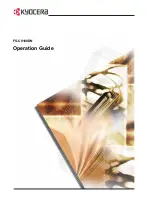
26
semireg/-12VDC and switching reg5VDC on the main PCB. The unreg30 to 40VDC
drives the printhead and stepper motors. The DP6 also develops unregulated -30 to -40VDC to drive the
printhead.
The control electronics are based on a 6809 microprocessor, a 64 Kbyte EPROM, an 8K (DP6) or 32K (DP7)
byte RAM, a 6522 I/O & timer device and an 8251 serial I/O communication device. The main PCB also
contains circuitry for interfacing to the keyboard/display assembly, driving the printhead and stepper motors
and providing signal level conversion for the serial interface signals. The driver electronics include switching
transistors that drive the printhead and 4 H-Bridge switching regulators that drive the carriage and document
drive stepper motors.
4.1.5 Keypad/Display Assembly
The keyboard/display assembly consists of a 16 key keypad arranged in a 4 x 4 scanning matrix and a 2 line
by 16 character dot matrix LCD display module. The display buffers 32 characters of data and generates the
dot patterns and timing to drive the LCD. The keypad assembly also contains an optical slot sensor that
detects removal of the cabinet lid.
4.2
ELECTRONICS IN DETAIL - Refer to #72080 (#72115 for DP7) Schematic
The following sections describe the DP6 with DP7 differences described in parentheses.
4.2.1 Power Supply
The center-tapped 48VAC supplied from the power transformer is converted to unreg/-30VDC (+30
only in DP7) by diode bridge D3 to 6 (half bridge D3 & D4) and filter capacitors C18 and C19 (C22). The
printhead is driven from +/-30VDC (+30 VDC only) and the stepper motors are driven from +30 VDC
protected by a 0.75A fuse F1. Semireg12VDC is generated from +30VDC by bleeder resistor divider
R44 & 45 (R36 & 37) and linear regulator Q14 (Q31). In the DP6 semiregulated -12VDC is generated from -
30VDC by bleeder resistor divider R38 & 39 and linear regulator Q13. (In the DP7 semiregulated -12VDC is
generated from +12VDC by a 7662 switching inverter U10.) +5VDC to power the logic is generated from +30
VDC by switching regulator Q15 (Q35) using Schottky diode D20 (D37) and output filter L1,C31 (C36). The
100KHz switching frequency is set by C29 & R51 (C25 & R41).
The 48VAC input charges up C6 (C35) through D1,D2 and R1 (R40). The C6 (C35) voltage is monitored by
precision reference Q1 (Q33) to insure correct operating voltages during power-up and power-down. Q1
(Q33) provides a PWROK signal through Q2 (Q34) to the microprocessor and an enable signal to the device
decoding logic.
4.2.2 Microprocessor System
The 6809 microprocessor U23 (U26 in DP7) has a 1.0 (0.5) microsecond cycle time which it generates from
4MHz (8mhz) crystal Y1.
Once each cycle the 6809 provides a timing pulse on U23 (U26) pin 34 for
synchronizing the devices on the data bus and updates the address information on pins A0-A15. The high
order address lines are decoded by a 74HC139 U11 (PAL U13). The decoded outputs are utilized as chip
selects to the RAM, EPROM and other LSI devices so that the corresponding device can be read or written to
by the 6809.
In the DP6 the 8 KByte RAM U21 is selected by U11 pin 6 when A15, 14 & 13 are all low. (In the DP7 the 32
Kbyte U25 is selected by U13 pin 16 when A15 is low unless A14 & 13 are both high and any bank select line
BNK1 to 3 is low which selects EPROM or unless A14,12 & 11 are low and A13 is high which selects I/O
devices.) The RAM provides work space and buffer memory for the 6809. All printer, communication and
service configuration parameters are also stored in the RAM which is powered by a 3 Volt lithium battery when
AC power is turned off. (Later versions of the DP6 and the DP7 uses serial EEPROM (U15A DP6; U11 DP7)
to store parameters and have no battery.)
















































